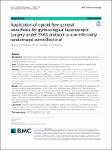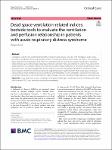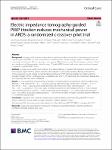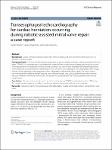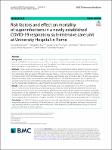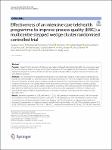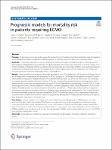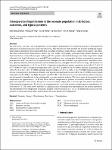Search
Author
- Osman, Ahmed I. (5)
- Daqing, Ma (3)
- Jorgensen, Ed (3)
- Li, Yan (3)
- next >
Subject
- kinh tế (26)
- Economics (12)
- programming (10)
- XRD (10)
- next >
Date issued
- 2020 - 2025 (2129)
- 2010 - 2019 (129)
- 2000 - 2009 (9)
- 1999 - 1999 (1)
Has File(s)
Search Results
Enhanced recovery after surgery (ERAS) is now widely used in various surgical fields including gynecological laparoscopic surgery, but the advantages of opioid-free anesthesia (OFA) in gynecological laparoscopic surgery under ERAS protocol are inexact. |
Cumulative evidence has demonstrated that the ventilatory ratio closely correlates with mortality in acute respiratory distress syndrome (ARDS), and a primary feature in coronavirus disease 2019 (COVID-19)-ARDS is increased dead space that has been reported recently. Thus, new attention has been given to this group of dead space ventilation-related indices, such as physiological dead space fraction, ventilatory ratio, and end-tidal-to-arterial PCO2 ratio, which, albeit distinctive, are all global indices with which to assess the relationship between ventilation and perfusion. |
In patients with acute respiratory distress syndrome undergoing mechanical ventilation, positive end-expiratory pressure (PEEP) can lead to recruitment or overdistension. Current strategies utilized for PEEP titration do not permit the distinction. Electric impedance tomography (EIT) detects and quantifies the presence of both collapse and overdistension. We investigated whether using EIT-guided PEEP titration leads to decreased mechanical power compared to high-PEEP/FiO2 tables. |
Cardiac herniation has been reported in thoracic trauma and after pneumonectomy; however, it is sporadic in cardiac surgery. |
Little is known on the burden of co-infections and superinfections in a specific setting such as the respiratory COVID-19 sub-intensive care unit. This study aims to (i) assess the prevalence of concurrent and superinfections in a respiratory sub-intensive care unit, (ii) evaluate the risk factors for superinfections development and (iii) assess the impact of superinfections on in-hospital mortality. |
Supporting the provision of intensive care medicine through telehealth potentially improves process quality. This may improve patient recovery and long-term outcomes. We investigated the effectiveness of a multifaceted telemedical programme on the adherence to German quality indicators (QIs) in a regional network of intensive care units (ICUs) in Germany. |
Esmolol as one treatment of sepsis induced cardiomyopathy (SIC) is still controversial. The objective of this study is to evaluate cardiac function after reducing heart rate by Esmolol in patients with SIC using speck-tracking echocardiography. |
Intra-abdominal hypertension (IAH) is frequently present in the critically ill and is associated with increased morbidity and mortality. Conventionally, intermittent ‘spot-check’ manual measurements of bladder pressure in those perceived as high risk are used as surrogates for intra-abdominal pressure (IAP). True patterns of IAH remain unknown. We explored the incidence of IAH in cardiac surgery patients and describe the intra-and postoperative course of IAP using a novel, high frequency, automated bladder pressure measurement system. |
To provide an overview and evaluate the performance of mortality prediction models for patients requiring extracorporeal membrane oxygenation (ECMO) support for refractory cardiocirculatory or respiratory failure. |
The risk factors, outcomes, and typical patterns of intraoperative hypothermia were studied in neonates to better guide the application of insulation measures in the operating room. This retrospective study enrolled 401 neonates undergoing surgery under general anaesthesia with tracheal intubation, including abdominal surgery, thoracic surgery, brain surgery, and others. The study collected basic characteristics, such as age, sex, weight, birth weight, gestational week, primary diagnosis and American Society of Anaesthesiologists (ASA) grade. |

